- Home
- Quizzes
- My Quiz Activity
- Newsletters
- Sports Betting
- MY FAVORITES
- Add Sports/Teams
- SPORTS
-
NFL
- NFL Home
- Arizona Cardinals
- Atlanta Falcons
- Baltimore Ravens
- Buffalo Bills
- Carolina Panthers
- Chicago Bears
- Cincinnati Bengals
- Cleveland Browns
- Dallas Cowboys
- Denver Broncos
- Detroit Lions
- Green Bay Packers
- Houston Texans
- Indianapolis Colts
- Jacksonville Jaguars
- Kansas City Chiefs
- Las Vegas Raiders
- Los Angeles Chargers
- Los Angeles Rams
- Miami Dolphins
- Minnesota Vikings
- New England Patriots
- New Orleans Saints
- New York Jets
- New York Giants
- Philadelphia Eagles
- Pittsburgh Steelers
- San Francisco 49ers
- Seattle Seahawks
- Tampa Bay Buccaneers
- Tennessee Titans
- Washington Commanders
-
MLB
- MLB Home
- Arizona Diamondbacks
- Atlanta Braves
- Baltimore Orioles
- Boston Red Sox
- Chicago White Sox
- Chicago Cubs
- Cincinnati Reds
- Cleveland Guardians
- Colorado Rockies
- Detroit Tigers
- Houston Astros
- Kansas City Royals
- Los Angeles Angels
- Los Angeles Dodgers
- Miami Marlins
- Milwaukee Brewers
- Minnesota Twins
- New York Yankees
- New York Mets
- Oakland Athletics
- Philadelphia Phillies
- Pittsburgh Pirates
- San Diego Padres
- San Francisco Giants
- Seattle Mariners
- St. Louis Cardinals
- Tampa Bay Rays
- Texas Rangers
- Toronto Blue Jays
- Washington Nationals
-
NBA
- NBA Home
- Atlanta Hawks
- Boston Celtics
- Brooklyn Nets
- Charlotte Hornets
- Chicago Bulls
- Cleveland Cavaliers
- Dallas Mavericks
- Denver Nuggets
- Detroit Pistons
- Golden State Warriors
- Houston Rockets
- Indiana Pacers
- Los Angeles Clippers
- Los Angeles Lakers
- Memphis Grizzlies
- Miami Heat
- Milwaukee Bucks
- Minnesota Timberwolves
- New Orleans Pelicans
- New York Knicks
- Oklahoma City Thunder
- Orlando Magic
- Philadelphia 76ers
- Phoenix Suns
- Portland Trail Blazers
- Sacramento Kings
- San Antonio Spurs
- Toronto Raptors
- Utah Jazz
- Washington Wizards
-
NHL
- NHL Home
- Anaheim Ducks
- Arizona Coyotes
- Boston Bruins
- Buffalo Sabres
- Calgary Flames
- Carolina Hurricanes
- Chicago Blackhawks
- Colorado Avalanche
- Columbus Blue Jackets
- Dallas Stars
- Detroit Red Wings
- Edmonton Oilers
- Florida Panthers
- Los Angeles Kings
- Minnesota Wild
- Montreal Canadiens
- Nashville Predators
- New Jersey Devils
- New York Islanders
- New York Rangers
- Ottawa Senators
- Philadelphia Flyers
- Pittsburgh Penguins
- San Jose Sharks
- Seattle Kraken
- St. Louis Blues
- Tampa Bay Lightning
- Toronto Maple Leafs
- Vancouver Canucks
- Vegas Golden Knights
- Washington Capitals
- Winnipeg Jets
- NCAAF
- NCAAM
- Boxing
- Entertainment
- Lifestyle
- Golf
- MMA
- Soccer
- Tennis
- Wrestling
- More Sports
- RESOURCES
- My Account
- YB on Facebook
- YB on Twitter
- YB on Flipboard
- Contact Us
- Privacy Policy
- Terms of Service

Small-school players who became top-10 NFL draft picks
Here are the players from low-tier Division I schools, or programs outside the Division I-FBS level, that became top-10 picks in the NFL's common draft era (1967-present).
2021: Trey Lance, North Dakota State
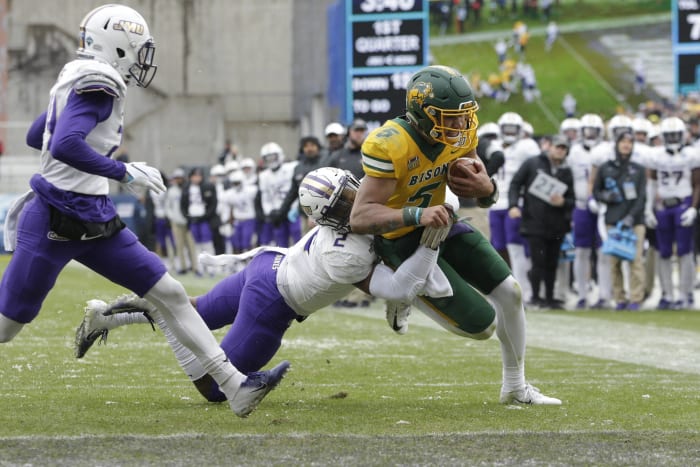
A Division I-FCS dynasty, North Dakota State sent three straight starting quarterbacks to the NFL. Easton Stick's successor went almost as high as Carson Wentz, rising to the No. 3 overall pick. The 49ers traded up from No. 12 and were consistently connected to Alabama's Mac Jones, and later reporting had Kyle Shanahan preferring Jones. Nevertheless, San Francisco landed on Lance, a historically unusual prospect. Lance dropped a 28-0 TD-INT ratio as a freshman before COVID-19 nixed the Bison's 2020 season. He is positioned to lead a contender in 2022, once the 49ers conclude their Jimmy Garoppolo exit saga.
2017: Corey Davis, Western Michigan
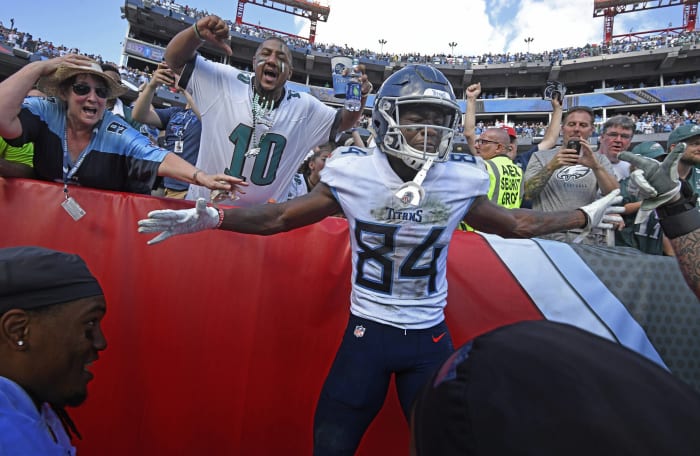
The Mid-American Conference has recently seen a few of its stars land in the top 10, but this is a recent phenomenon. Davis became the most recent MACtion participant to rise into the top 10, going fifth overall to the Titans. Davis was the first wideout off the board that year, preceding top-10 choices Mike Williams and John Ross. The trio has delivered inconsistency. But Davis dominated at Western Michigan, eclipsing 1,400 yards in each of his final three seasons. The eventual Jets signee has been a productive pro but has yet to top 1,000 yards in a campaign.
2016: Carson Wentz, North Dakota State
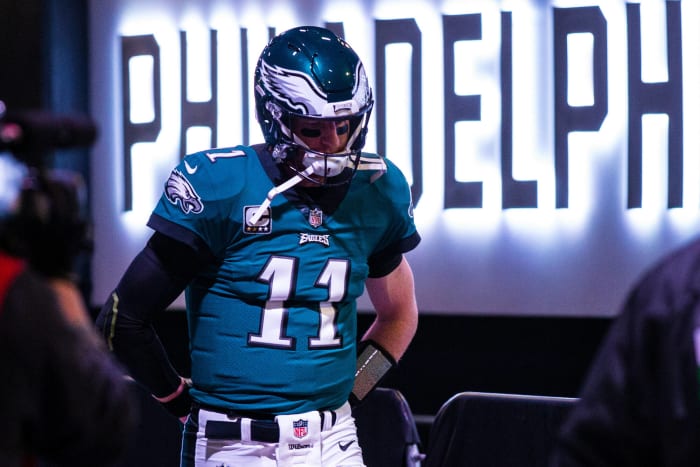
One of the most memorable pre-draft risers, Wentz became the first non-Division I-FBS quarterback taken in the top 10 in 21 years. The D-I-FCS national championship-winning QB impressed the Eagles to the point they sent the Browns a bounty (five picks, including a 2017 first-rounder) to move from No. 8 to No. 2. The Eagles traded 2015 starter Sam Bradford to make room for Wentz as a rookie, and the youngster was on track for the 2017 MVP award. But Wentz has not recaptured that form since the ACL tear that ended his second season and led to Nick Foles' glory montage. Becoming increasingly unpopular, Wentz is now on his third NFL team in three years.
2014: Khalil Mack, Buffalo
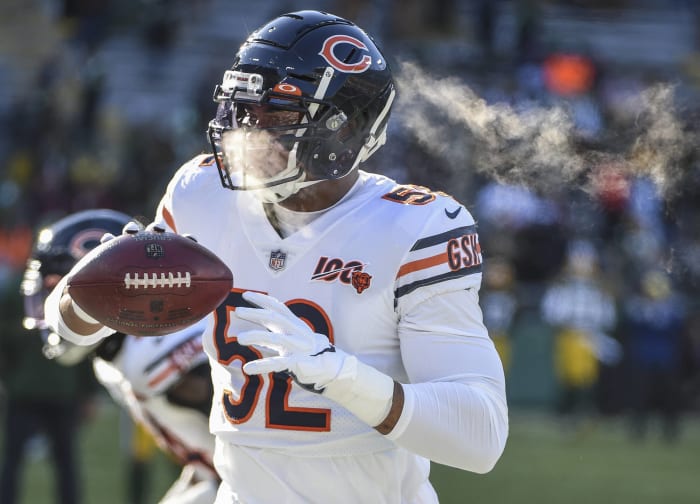
South Carolina's Jadeveon Clowney was the consensus top pick in 2014; Mack loomed as a consolation prize. The latter soon proved a far superior pass rusher. The Raiders took Mack fourth overall, with GM Reggie McKenzie beginning a cornerstone draft that included Derek Carr and Gabe Jackson. Mack produced one 10-plus-sack slate at Buffalo but ripped off four straight in Oakland beginning in 2015. The Raiders sported the 26th-ranked defense in 2016, yet Mack's dominance still won him Defensive Player of the Year honors. After three Pro Bowls with the Bears, Mack will play alongside 2016 No. 3 overall pick Joey Bosa with the Chargers.
2013: Eric Fisher, Central Michigan
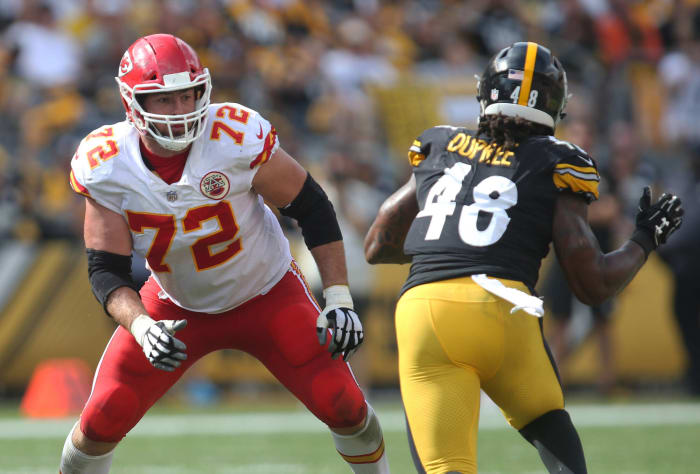
Not unlike the 2022 draft, 2013's lacked a top quarterback and a surefire elite talent. This stuck the Chiefs with a mid-major tackle. While 2013's top 10 produced a few memorable busts, the Chiefs taking Fisher first overall eventually turned out well. The scrutinized blocker lasted eight seasons in Kansas City and proved pivotal during Patrick Mahomes' rise. Fisher's Achilles tear in the 2020 AFC title game changed Super Bowl LV's trajectory and the future of Kansas City's offensive line. The tackle chosen second overall, Texas A&M's Luke Joeckel, lasted five NFL seasons.
2003: Byron Leftwich, Marshall
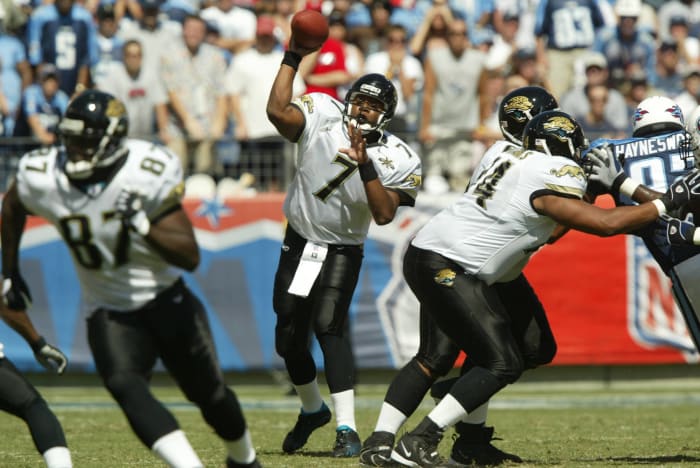
The Jaguars have used four top-10 picks on quarterbacks in their 27-draft history. Leftwich was the first. The Vikings' infamous snafu with their pick clock led to multiple teams -- including the Jags -- jumping them in line. The No. 7 overall pick, Leftwich replaced Mark Brunell early, with the ninth-year starter going down with an injury early in 2003. Leftwich, who threw 68 touchdown passes for newly Division I Marshall from 2001-02, entered the NFL after breaking his leg as a senior. The current Buccaneers OC did not pan out as a starter but did play 10 seasons. He will probably be better remembered as a coach.
1995: Steve McNair, Alcorn State
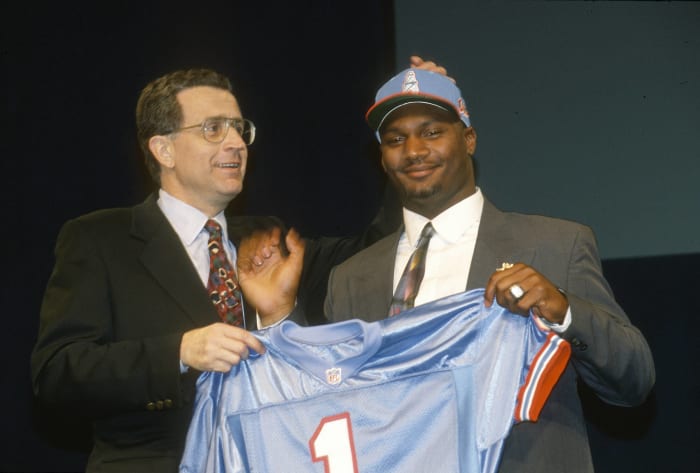
The Oilers traded Warren Moon for a modest haul in 1994 and plunged to the NFL's basement. A year later, they selected their next franchise centerpiece. After a 2-14 season, Houston drafted McNair third overall. Despite playing in what was then Division I-AA, McNair finished third in the Heisman voting. "Air McNair" wore out his arm in 1994, compiling 5,799 yards of total offense (4,863 passing) and throwing 44 TD passes. The dual-threat took the Oilers' reins in 1996 and kept them for the Titans until 2005. The Titans have taken three QBs in the top 10 since; none has lasted more than five seasons with the team.
1993: Willie Roaf, Louisiana Tech
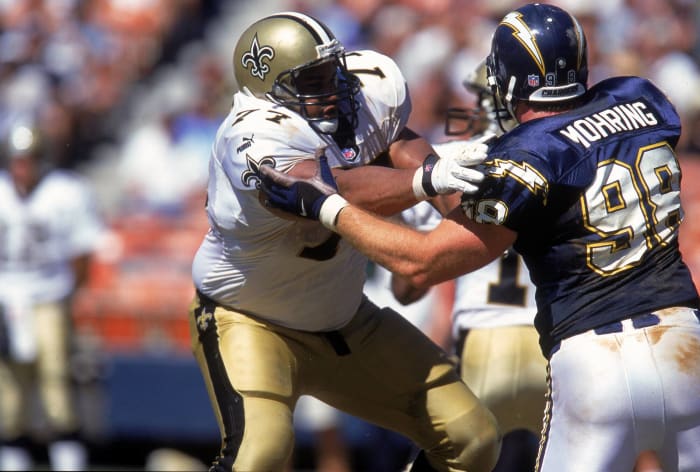
The Saints acquired 1993's No. 8 overall pick from the Lions in a trade for former Defensive Player of the Year Pat Swilling. They drafted an even better player, selecting their left tackle of the future. Louisiana Tech had moved to Division I since Terry Bradshaw's days but played as an off-grid independent during Roaf's tenure. Roaf became a Day 1 starter in New Orleans and kept the blindside gig until 2000, making seven straight Pro Bowls as a Saint. After Roaf helped the Saints back to the playoffs in 2000, he landed with the Chiefs via trade. Paving lanes for Priest Holmes and Larry Johnson ended up securing Roaf Hall of Fame entry.
1991: Eric Swann, Wake Technical Community College
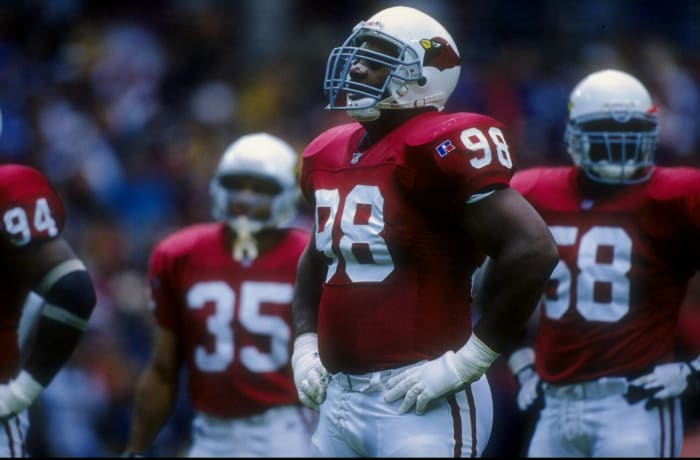
The strangest case on this list, Swann managed to be the sixth overall pick in 1991 despite having not played college football. He is the only player in the common draft era to go in the first round without doing so. A top-tier recruit, Swann saw academic issues derail his entrance to the college ranks. The defensive tackle instead played semipro ball in Massachusetts. Despite this apparent anonymity, Swann participated at the scouting combine and caught the Cardinals' eye after running a 4.7-second 40-yard dash at 307 pounds. Swann played 10 seasons, nine with the Cards, and made two Pro Bowls.
1979: Phil Simms, Morehead State
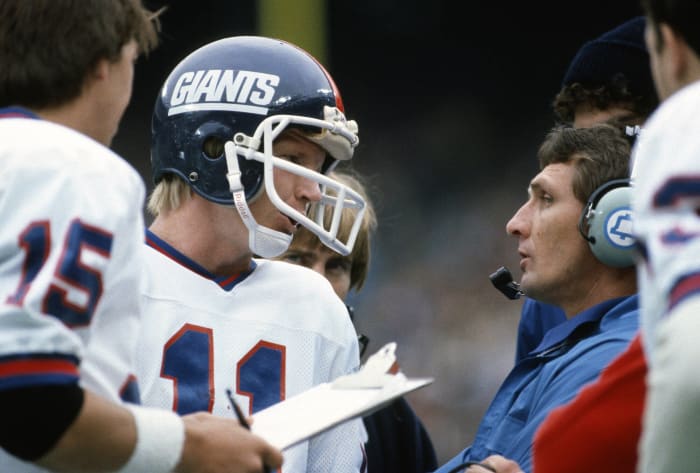
Morehead State (Kentucky) moved from Division II to Division I-AA before Simms' senior season. His college numbers still did not impress, but he shined in pre-draft workouts. This led a Giants franchise with a new GM (future Hall of Famer George Young) and head coach (Ray Perkins) to draft him seventh overall. Boos emerged at the 1979 draft after Simms' name was called, and the Giants staffer charged with writing Simms' name on the draft card initially misspelled his college. The small-school passer's name was called four spots after QB Jack Thompson's; the Giants draftee lasted 15 years in New York and collected two Super Bowl rings.
1976: James Hunter, Grambling State
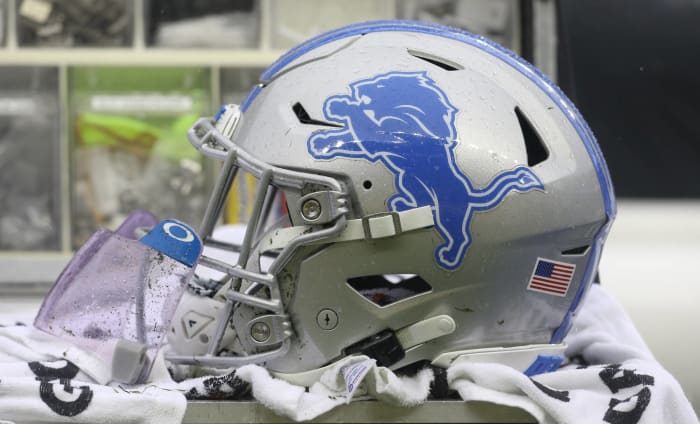
Small-school draft choices occurred more frequently at this point. Several top athletes became first-round picks from historically Black schools due largely to limited collegiate options for players of color in the NFL's first several decades. Hunter is the most recent HBCU alum to be drafted in the top 10, going 10th overall to the Lions. Future Hall of Fame Lions cornerback Lem Barney mentored Hunter, a 6-foot-2 corner. The latter intercepted seven passes as a rookie and bounced between corner and safety as a pro. Hunter intercepted 27 passes in seven seasons with the Lions before a 1982 neck injury ended his career.
1975: Walter Payton, Jackson State
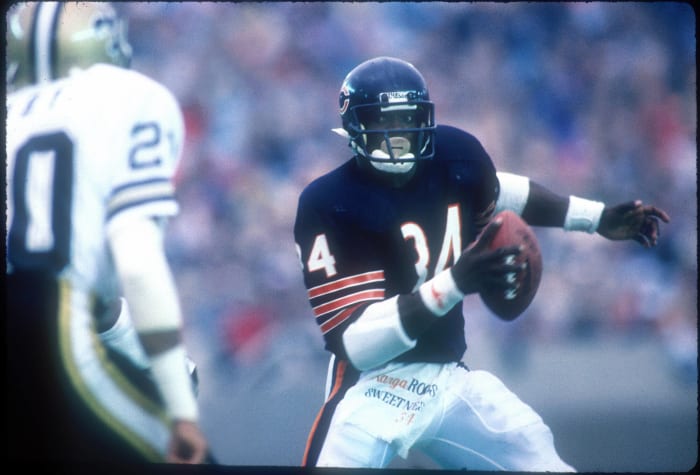
Payton blazed to the NFL via the HBCU route, thriving for a loaded Jackson State (Mississippi) program to catch the Bears' attention. The Division I-AA superstar went to Chicago as the fourth overall pick, finally giving the Bears their Gale Sayers replacement. A do-it-all back with a punishing style and historic durability, Payton achieved just about everything possible for a back. He set single-game and career-rushing records, earned MVP acclaim for carrying a flawed 1977 Bears team to the playoffs, and later won a Super Bowl (after dropping "Super Bowl Shuffle" bars via green-screen). The Hall of Famer is one of the most celebrated football players ever.
1975: Robert Brazile, Jackson State
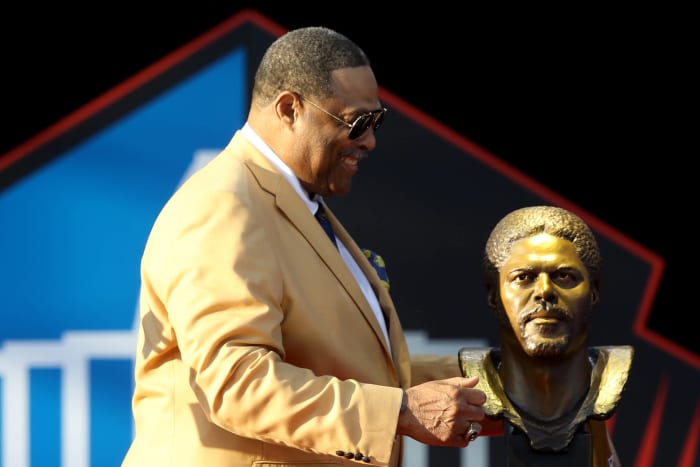
The Division I-AA school produced two top-six picks in 1975, with the Oilers drafting Brazile shortly after Payton's name was called. Brazile later joined Payton and Jackson State O-lineman Jackie Slater, a 1976 third-round pick, in the Hall of Fame. A feared pass rusher from the linebacker spot well before Lawrence Taylor made such a role commonplace, Brazile joined an Oilers team housing two other Canton-bound defenders -- D-linemen Elvin Bethea and Curley Culp -- to help key a late-'70s rebound. The '75 draft saw three of the first six picks (Bethea, Payton, and Randy White) secure Hall of Fame entry.
1975: Gary Johnson, Grambling State
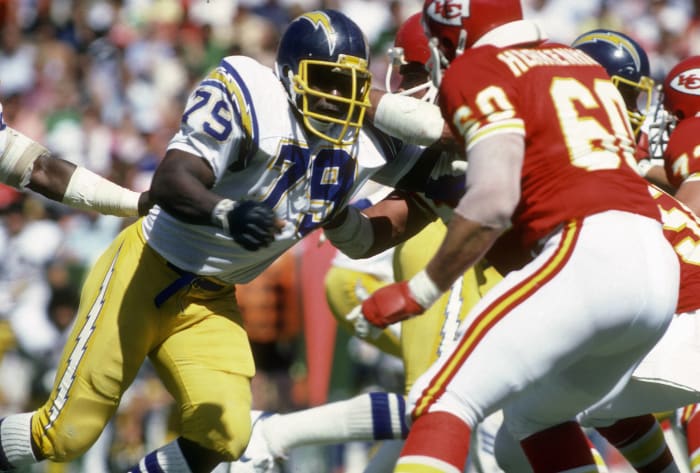
On Chargers teams known for defensive letdowns, Johnson did his part to help those Don Coryell-coached squads. The Chargers drafted Johnson before their Air Coryell offense formed, taking the defensive tackle eighth overall during the Tommy Prothro-Harland Svare regime. Retroactively credited with three double-digit sack seasons, Johnson achieved acclaim during the Air Coryell years of the late 1970s and early '80s. His 17.5 sacks in 1980 alongside Hall of Fame-bound D-end Fred Dean are among the most ever by a D-tackle in a season. Johnson later joined Dean on the 49ers in 1984, collecting a Super Bowl ring.
1974: Ed "Too Tall" Jones, Tennessee State
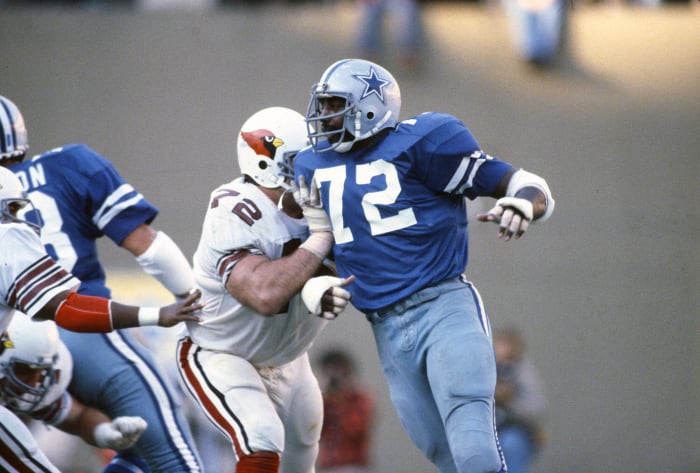
The most recent HBCU star to be selected first overall, Jones rewarded the Cowboys with a 15-year career. Once on track to play baseball at Arizona State, the 6-foot-9 athlete chose Division I-AA Tennessee State after his father died during his senior year of high school. The raw talent blossomed into a coveted pass rusher and delivered as a pro. Jones started for three Super Bowl-bound Dallas teams and has been credited with 106 sacks. Jones managed to play 15 years despite retiring to pursue boxing in 1979, resuming his partnership with Randy White and Harvey Martin a year later.
1974: Waymond Bryant, Tennessee State
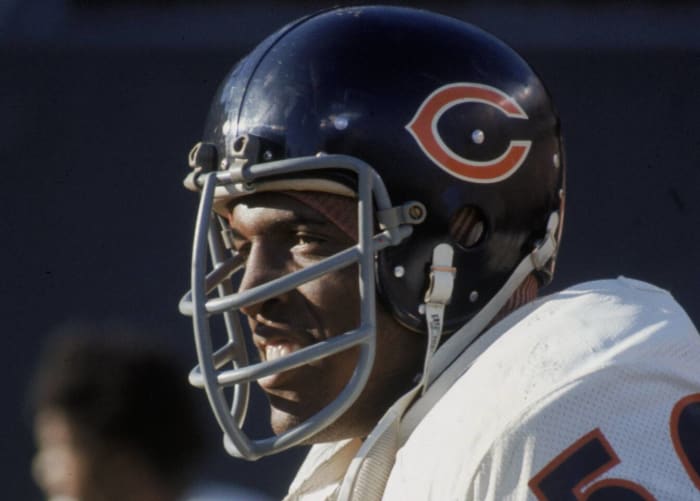
The Bears went the small-school route on a few occasions to start 1970s drafts. They drafted Jones' slightly less heralded teammate fourth overall in 1974. Six linebackers went off the board in Round 1 of the 26-team first round that year; Bryant heard his name called first. The Tennessee State standout started four seasons with the Bears, the last of which was a playoff squad, but missed the entire 1978 season due to a shoulder injury. Bryant, whose tackle on Joe Namath ended his career in 1977, did not play again after his own injury shortly after.
1973: Wally Chambers, Eastern Kentucky
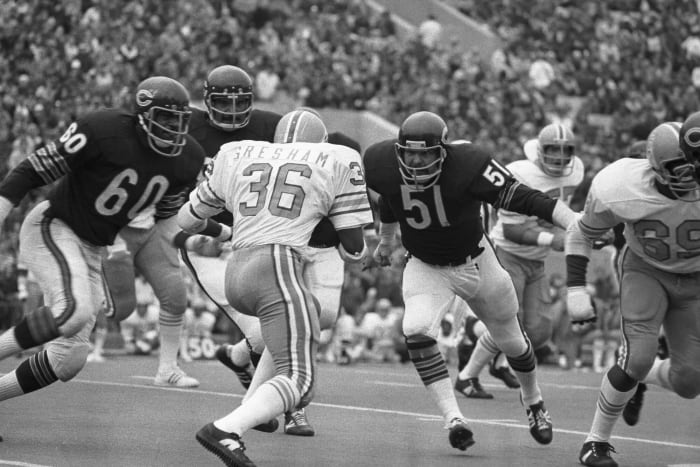
The Bears hit big on their 1973 small-school investment. By going eighth overall, Chambers became the highest drafted player in Ohio Valley Conference history. Chicago's defensive tackle pick became the Defensive Rookie of the Year and, in 1976, finished second in the Defensive Player of the Year voting (behind only Jack Lambert) after a 14-sack season. Chambers tallied 37 sacks in his first four seasons, but a knee injury sustained at the 1976 Pro Bowl bothered him during the rest of his career. The Bears traded Chambers to the Buccaneers in 1978, in a deal that led Dan Hampton to Chicago, and his career was over by 1980.
1972: Lionel Antoine, Southern Illinois
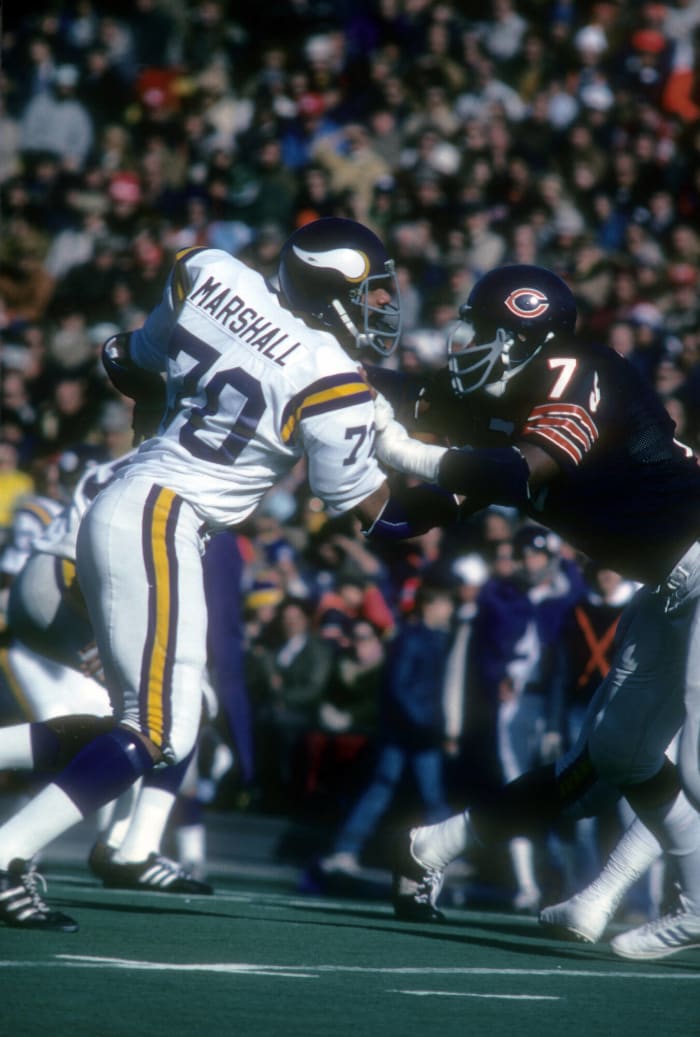
Like Chambers, Antoine did not land in the top 10 via the HBCU path, but he began the Bears' 1970s run of small-school first-rounders. A tight end with the Salukis, Antoine became a left tackle with the Bears. Antoine's prospects as a tackle led to him becoming the No. 3 overall choice in 1972, but the 6-foot-6 blocker did not end up a long-term fixture in Chicago's lineup. Not a first-string regular until 1974, Antoine battled a knee injury during his career -- one that caused him to miss all of the 1978 season. The Bears moved on after the '79 slate. Of their four straight small-school first-rounders, only Payton remained on the team by then.
1972: Jerome Barkum, Jackson State
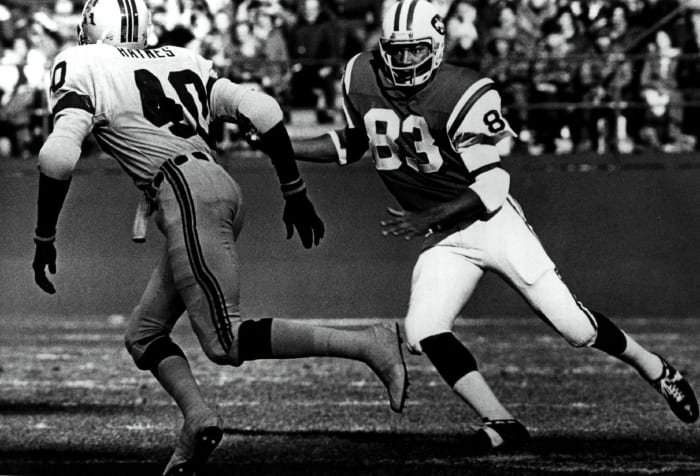
Ranking last in passing in 1971, the Jets took a hybrid pass-catcher ninth overall. The 6-foot-3, 218-pound Barkum entered the early-'70s NFL as a supersized wide receiver but later moved to tight end. As a young player, Barkum stepped in for a Jets team that saw Don Maynard's decorated Big Apple run end after the 1972 season. The ex-HBCU standout dropped an 810-yard season in 1973, making the Pro Bowl despite Joe Namath playing just five games due to injury. Barkum managed to play 12 seasons, helping the Jets to the 1981 and '82 playoffs as a veteran tight end. He finished his career behind only Maynard in Jet receptions.
1971: Dan Pastorini, Santa Clara
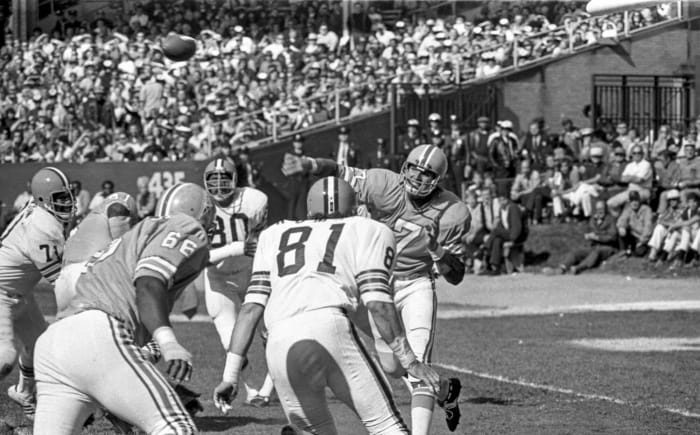
The Santa Clara football team ceased operations in 1992, but the school best known for late-night Gonzaga matchups once was part of a historic quarterback draft. The 1971 draft was the first to start QB-QB-QB when it began with Stanford's Jim Plunkett, Ole Miss' Archie Manning, and Pastorini. Each went to terrible teams, and while Manning drew the shortest straw (the perennially woeful Saints), the Oilers went 2-26 between Pastorini's second and third seasons. Pastorini still lasted nine years in Houston and teamed with Earl Campbell to take the team to two AFC championship games -- both losses to the Steelers.
1971: Richard Harris, Grambling State
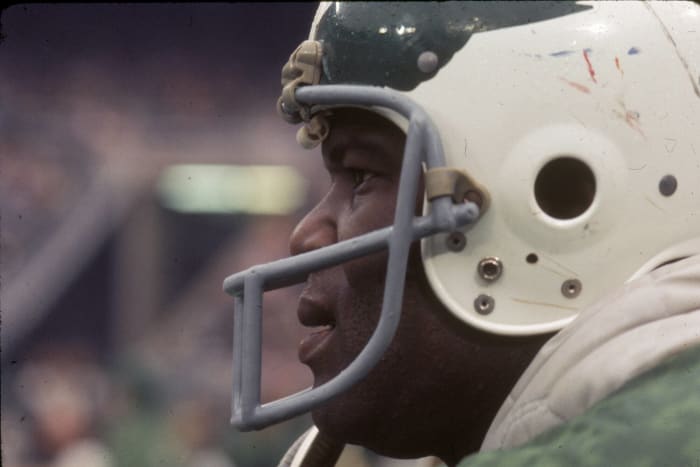
No draft featured more small-school talent go in the top 10. A defensive end, Harris went fifth overall to the Eagles. The ex-Eddie Robinson charge wowed teams with a 4.7-second 40-yard dash at 265 pounds, an eye-catching display for the era. But Harris landed with the Eagles at a bad time. Philadelphia finished under .500 in each of Harris' three years with the team, and, despite a 7.5-sack rookie season, he was moved to defensive tackle during his tenure. Harris wound up with the Bears' stable of small-school first-rounders by 1974, via trade, and finished his seven-year career as a starter for the expansion Seahawks.
1971: Joe Profit, Louisiana-Monroe
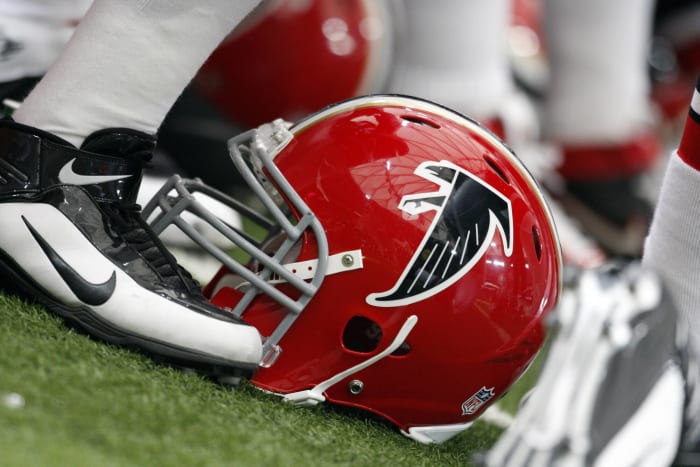
The Jets took John Riggins sixth overall, and the Falcons resumed the small-school portion of that year's top 10 by taking another running back at 7. Profit blazed a trail at Northeast Louisiana (later renamed Louisiana-Monroe), becoming the first Black player to compete in the Warhawks' conference (the Gulf States Conference). A knee injury as a rookie hampered Profit's NFL career, which lasted just three years. Profit, who later played in the short-lived World Football League, rushed for just 471 yards in the NFL.
1971: Frank Lewis, Grambling State
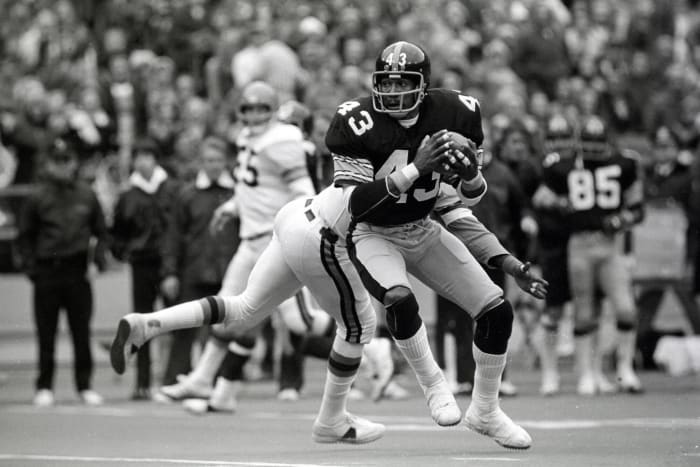
Eddie Robinson's team had five players drafted in the first two rounds in 1971. The No. 8 overall choice, Lewis lasted the longest. Beating Lynn Swann and John Stallworth to Pittsburgh by three years, Lewis kept his starting gig for both the Steelers' 1974 and '75 Super Bowl-winning teams. After Stallworth and Swann became Terry Bradshaw's go-to targets in the mid-1970s, Lewis enjoyed a resurgence in Buffalo. Traded to the Bills in 1978, Lewis posted two 1,000-yard seasons and helped Buffalo mount a mini-run in the early '80s. This included a 1981 Pro Bowl season he capped with a 158-yard showing in a Bills shootout playoff win over the Jets.
1971: Isiah Robertson, Southern
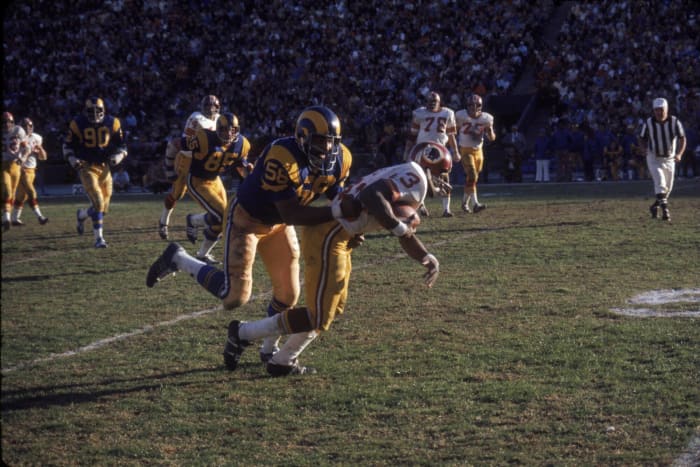
Robertson later joined Lewis on Chuck Knox's playoff-bound Bills teams, but the speedy linebacker starred with the Rams first. The Rams chose "Butch" Robertson 10th overall from Grambling's top rival. He became one of the best linebackers of the 1970s, making six straight Pro Bowls from 1972-77 and doing plenty to install the Rams as perennial NFC West champions. Robertson's pick-six on future Hall of Famer Sonny Jurgensen sealed a Rams 1974 playoff win. Knox traded for his former Rams charge in 1979, and Robertson finished his 12-year career as a full-time Bills starter.
1970: Terry Bradshaw, Louisiana Tech
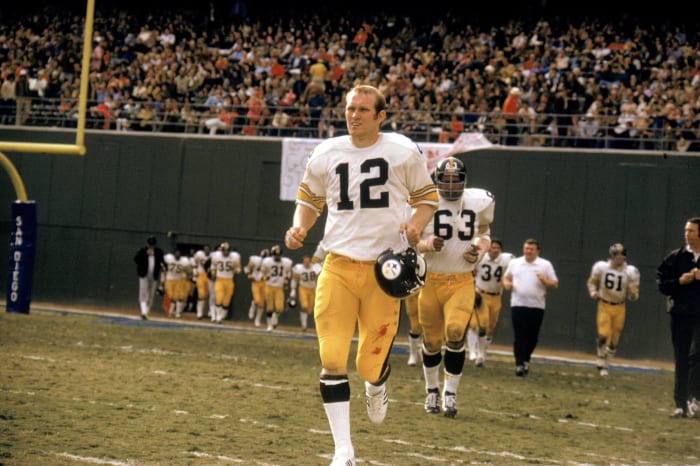
Not a Division I program at this point, Louisiana Tech nevertheless saw its quarterback taken first overall. Bradshaw nearly went to the Bears, with a coin toss between the 1-13 teams determining who earned 1970's top pick. The Bears' "heads" call failed, and Bradshaw played the next 14 seasons with the Steelers. Chicago traded out of the No. 2 spot but did not solve its quarterback issue until the early 1980s. During Jim McMahon's childhood, Bradshaw helped transform a Steelers franchise that had been one of the NFL's worst. Four Super Bowl wins and the 1978 MVP award followed for the gregarious QB.
1970: Phil Olsen, Utah State
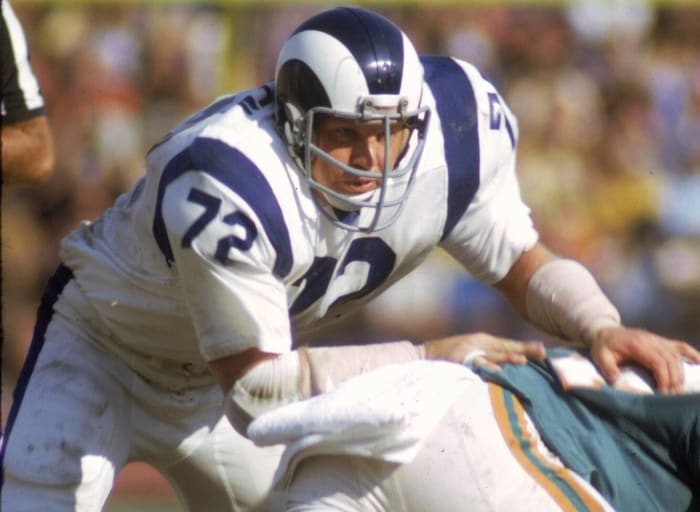
The younger brother of all-time great Merlin Olsen arrived in the NFL eight years later. The Patriots drafted the All-American defensive tackle fourth overall, but a rookie-year injury prevented him from playing in a game for the franchise. The younger Olsen became a rare 1970s free agent when a contract technicality allowed him to sign with another team. He chose the Rams, with whom Merlin still starred, leading to the Patriots receiving compensation for the defection. Phil Olsen started 15 games in four Rams seasons, before finishing his six-year career in Denver.
1970: Cedrick Hardman, North Texas
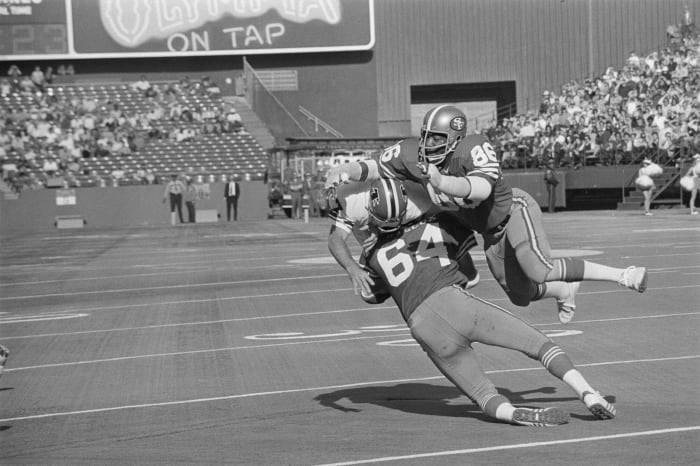
Part of the 49ers' Gold Rush defensive line in the 1970s, Hardman first teamed with "Mean" Joe Greene on North Texas' D-line in the late '60s. After Greene's 1969 move to the pros, North Texas credited Hardman with an absurd 38 sacks as a senior. The 49ers took the defensive end ninth overall, and Hardman played 10 seasons in San Francisco. He led the NFL with 18 sacks in 1971 and finished his career as the 49ers' all-time sack leader, with an unofficial total of 108. The two-time Pro Bowler helped the 49ers to three playoff berths and later collected a Super Bowl ring as a Raider in 1980.
1970: Ken Burrough, Texas Southern
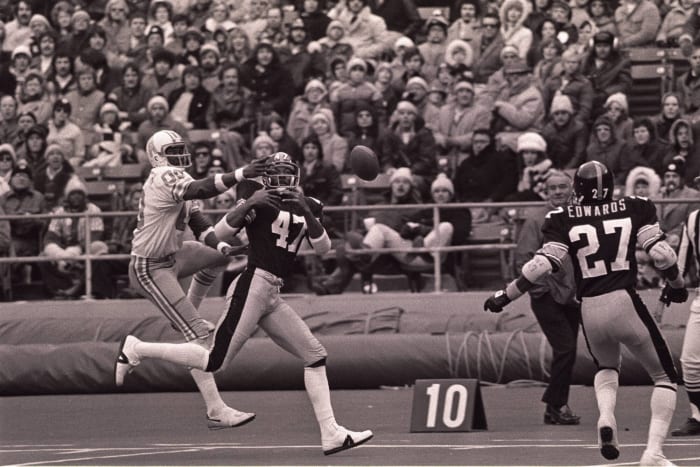
The last NFL player to wear 00, Burrough went one pick after Hardman in 1970. The 10th overall pick began his career with the Saints but was traded to the Oilers after just one season. Houston was set to select the Texas Southern alum in 1970 but landed him a year later. Burrough is the longest-tenured wide receiver in Oilers/Titans history, playing 11 years with the team. The 6-foot-4 deep threat led the NFL in receiving in 1975 and made two Pro Bowls, later helping the "Luv Ya Blue" Oilers teams to back-to-back AFC title games. Burrough was later inducted into the Black College Football Hall of Fame.
1969: Joe Greene, North Texas
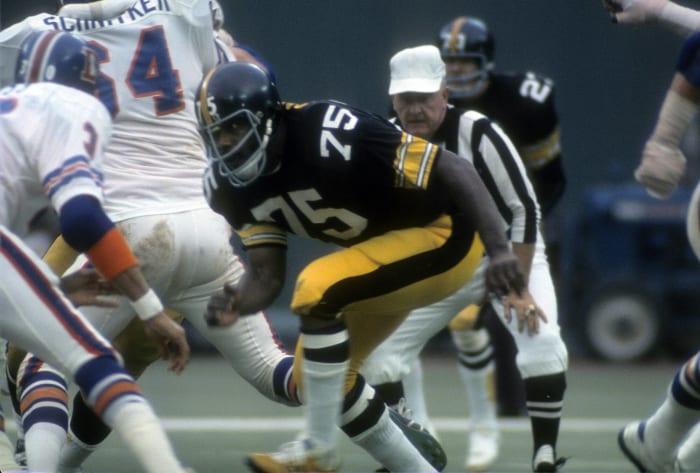
The Steel Curtain's foundational piece, Greene became the first Mean Green football player to be a first-round pick when he went fourth overall to the Steelers. The first of the Steelers' Chuck Noll-era Hall of Famers to arrive, being Noll's first pick as head coach, "Mean Joe" anchored the Steel Curtain's defensive line and became one of the greatest players in NFL history. Steelers fans were initially disappointed a small-school D-tackle led off the team's draft. Greene became a game-wrecking presence at the center of Pittsburgh's famed defense, playing 13 seasons and collecting every accolade possible.
1969: Marty Domres, Columbia
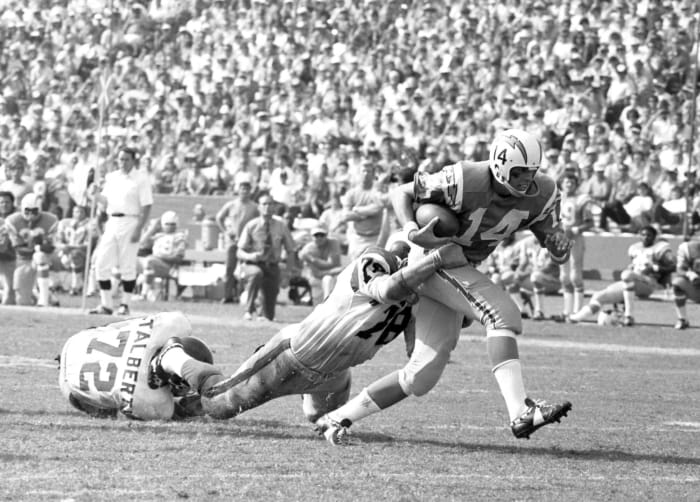
Despite rostering All-AFL quarterback John Hadl, the Chargers drafted Domres ninth overall. The Ivy Leaguer never factored in prominently in San Diego, sitting behind Hadl for most of his three-year tenure with the Bolts. The second quarterback chosen in 1969, going four picks behind Bengals choice Greg Cook, Domres later fetched a first-round pick in a 1972 trade with the Colts. He ended up replacing Johnny Unitas in Baltimore, leading to the legendary passer's trade to San Diego in 1973. But the Colts' 1973 Bert Jones pick relegated Domres back to the bench. He played nine NFL seasons.
1968: Claude Humphrey, Tennessee State
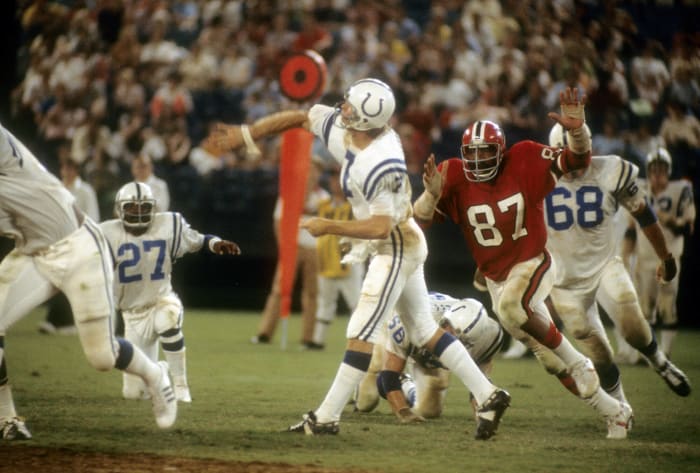
Already rostering top-flight linebacker Tommy Nobis, the Falcons paired the former No. 1 overall pick with 1968's third choice. While the Nobis-Humphrey tandem could not overcome other Falcons' deficiencies, both players became instant sensations. Humphrey followed Nobis by becoming NFL Defensive Rookie of the Year, and the defensive end reeled off four straight double-digit sack seasons to start his career. The future Hall of Famer finished with 130, collecting 15.5 of those for the Super Bowl-bound Eagles in 1980.
Sam Robinson is a Kansas City, Mo.-based writer who mostly writes about the NFL. He has covered sports for nearly 10 years. Boxing, the Royals and Pandora stations featuring female rock protagonists are some of his go-tos. Occasionally interesting tweets @SRobinson25.
More must-reads:
- The best wide receiver draft classes of all time
- The best NFL Draft classes of all time
- The '100 catches in an NFL season' quiz
Breaking News
Customize Your Newsletter
 +
+
Get the latest news and rumors, customized to your favorite sports and teams. Emailed daily. Always free!
Use of this website (including any and all parts and
components) constitutes your acceptance of these
Terms of Service and Privacy Policy.

